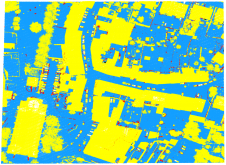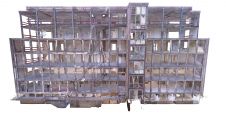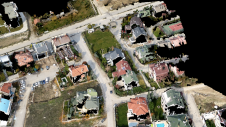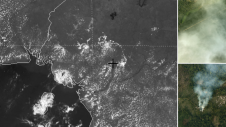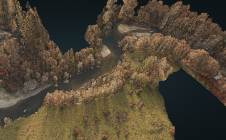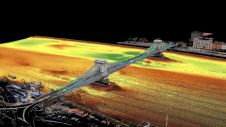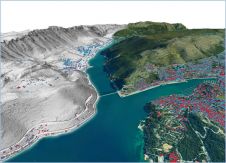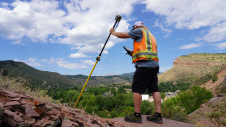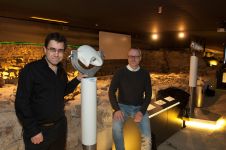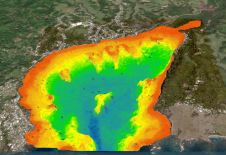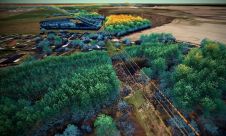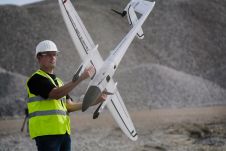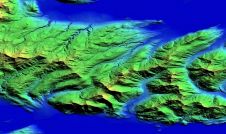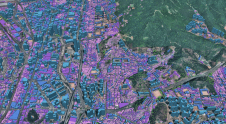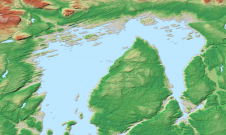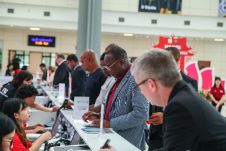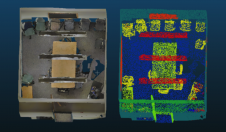A Focus on Underground Utilities - NWG Innovation Festival 2018
When the Northumbrian Water Group (NWG) held their second Innovation Festival in July 2018, it was an event like no other. The festival’s aim was to turn the concept of a typical business conference on its head. By staging the festival in an open field, complete with marquees, teepees and casually dressed attendees, NWG were going back to the roots of why people generally attend a festival: to release themselves from the predictability and routine of everyday business life. In doing so, the festival aimed to encourage a diverse group of people to think differently about innovation, and to share views and ideas from various different viewpoints - both commercial and non-commercial.
Despite the many distractions such as free yoga classes, the festival had a clear structure and focus. The event was geared around 12 distinct themes, with design-focused innovation ‘sprints’ aimed at addressing selected problem areas. During these sprints, design thinking was used to turn concepts and ideas into real projects, with a Problem-Solution-Execution approach applied to each of the problem areas.
地理空间的重要性
As would be expected of any event which is focused on reinventing and redesigning the utilities world, the geospatial industry had a strong presence at the festival. Neil Brammall, the CEO of Utility Survey Exchange, was one independent expert in attendance thanks to his domain expertise in the utilities geospatial sector. Neil, who has worked in the industry for over 17 years, is helping to take one of the projects from the Innovation Festival forward. Introducing why utilities are now an innovative space, he explained to me the current cutting-edge project, which is focused on developing a combined underground infrastructure map for the Northeast of England.
The ‘Mapathon’ sprint was sponsored by Ordnance Survey and jointly led with NWG. Entitled ‘Going deeper underground – can we build an underground map of the UK?’, and consisting of a team from utilities, local government, engineering and GIS expertise, the goal of the sprint was to: “Build a Common Infrastructure Map pilot for Newcastle and the surrounding area including water, wastewater, gas, electricity, telecoms and other underground services”. The essential aim of the sprint was to create a working system that allowed the demonstration of various use cases around obtaining information about the location of underground assets. These use cases ranged from support for safe working during excavations, through planned construction works to resilience planning.
These use cases actually arise from the supposed lack of a simple and consistent means to access all underground asset records in England and Wales. Considering this, topics such as interoperability and data sharing were high on the sprint’s agenda, along with the matter of data quality, accuracy, and how this could be improved.
Not Just a Technology Problem
Three broad streams were defined to progress different aspects of the sprint: Technical, Benefits and Business Case, and Data Sharing Agreement. Each of these streams helped to define the requirements, use cases and constraints for solutions to these different aspects of the central problem - based on insights shared by the participants. Structuring the sprint in this way was an important acknowledgement that the problem under consideration was not simply technological in nature, and that commercial, organisational and behavioural aspects are equally important. The business case development and benefits analysis were given particular focus, with PESTLE analysis (Political, Economic, Social, Technological, Legal, Environmental) being particularly impactful. Of equal importance was the draft data sharing agreement, which will form the basis for ongoing discussions and refinement to find a formulation that will allow organisations to share data - freely and securely.
在技术方面,工作架构provisionally agreed based on a ‘Hub’ model, whereby contributing organisations would upload copies of agreed data on a periodic basis to be served out to authorised recipients. A demonstrator system was developed based on this architecture, with services exposed that allowed the participants to develop proof of concept demonstrators to illustrate potential solutions for some of the use cases identified.
A Wider Agenda – UK Developments
The Mapathon sprint, like the NWG Festival more broadly, was about much more than having a nice collaborative festival experience. The event was a coordinated effort to build a community around the important topic of underground utility mapping for the purpose of safety and sustainability. It also represents a much wider movement in the UK to improve how things are done in this area.
两个主要发展是最近国lished initiatives which are geared towards the utilities sector. The first, Project Hades, funded by Transport for London (TfL) and sponsored by Thames Water, is focused on setting up a data sharing exchange between utilities and developing a combined underground infrastructure map for the London area.
The second, Project Iceberg, is a collaborative project between Ordnance Survey (OS), British Geological Survey (BGS) and Future Cities Catapult (FCC) exploring how to better capture, collect and share data about the subsurface in general, including underground assets and geological conditions. This initiative aims to demonstrate the value of interoperable data about the subsurface (including buried assets) and to find effective ways of sharing all this information among a wide range of relevant organisations, going beyond operational use cases of network operators. Phase 1 is now complete and has produced a comprehensive market research report and literature review, and started the work on defining a framework and standards to underpin data exchange (https://bit.ly/2zsbVQe). Phase 2 will consist of a series of research activities based on the use cases defined in Phase 1 and will get underway later this year.
International Examples Show the Way
Despite the growing interest in the issue of accessing underground utility data, a number of issues remain which are holding back data sharing and interoperability developments in this sector. These include concerns around data security, and uncertainty around the location of buried assets. After all, utilities can be high risk and anyone sharing information needs to have a high degree of certainty about their location.
在英国,人们越来越认识到由于缺乏可访问性和互操作性而引起的问题不会消失,并且可以在国际上找到如何改善情况的例子。有效共享地下资产数据的示例可以在比利时的佛兰德地区与Klip系统一起发现,并在苏格兰与保险库系统更靠近苏格兰的家。这两项举措都是由立法驱动的。倡议的概述,可以在http://docs.opengeospatial.org/per/17-048.html.
A Sprint to the Finish Line
Unlike most UK summer festivals, wherein the attendees are more often than not in need of recovery after the event, the overall feeling from the NWG festival was that the attendees, and in particular the sprint participants, left in an energised and enthusiastic mood. Amongst the delegates of the Mapathon sprint, the feeling is that excellent progress was made during the week.
所有参与者之间的合作精神,尤其是共享该活动数据的组织之间的合作精神令人难以置信,并且根据尼尔的经验,史无前例。
A number of demonstrations in response to use cases were developed “in the tent” during the week, including incorporation of Combined Infrastructure Map data in a third party web viewer and a demonstration of the availability of offline data. As an example, Neil Brammall was able to implement a link between the Utility Survey Exchange platform and the Combined Infrastructure Map, allowing feedback from the field to be uploaded and displayed in real-time.
该反馈循环的概念特别是公用事业数据经理,并且能够轻松,快速报告未知和错误记录的资产的能力被视为长期数据质量改进的关键。根据PAS128标准中概述的标准捕获的高质量调查数据也是如此。
简而言之,有很多有用的信息,这些信息没有找到回到资产所有者的方式,并且错过了提高地下资产权威记录的质量和准确性的机会。可以预期,通过为公用事业提供来自更多多种来源的验证数据来完成该圈子,从而使对不同位置的数据质量有更深入的了解将产生切实的操作效益。将这些额外的数据源带入起作用是公用事业调查交换系统的全部内容。
The Hard Work Starts Now
Now that the festival is over, the real work begins in overcoming the technical, commercial and cultural challenges of designing and implementing an operational data sharing hub. The priority will be to define a mechanism that will allow asset owners to share their data in a manner that is simple yet comprehensive and secure, and will then allow stakeholders with a legitimate requirement to access that data in a straightforward and usable manner.
There is no “one size fits all” solution to these requirements, so building in flexibility to suit a wide variety of existing business processes and systems will be key. Different organisations are at different points of their geospatial journey - some are raring to go with this proposition, while others will need a little help along the way.
Neil therefore advocates for a “hybrid” architecture with a low barrier to entry that will allow organisations at different stages of technological evolution to gain benefits from the system which will be crucial for widespread adoption.
展望未来,将评估“集线器”模型以外的其他体系结构,并特别考虑实时访问“实时”数据的好处,而不是定期快照。这种方法将从以前的倡议迈出重要一步。
Also of critical importance will be the need to find practical ways to improve data quality and accuracy. If utilities and other organisations are communicating and sharing with each other more effectively, the more opportunities there are to improve the authoritative record of the underground by sharing observations through online platforms.
Technological advances in machine learning, augmented reality, advanced survey techniques and AI may all help to improve our understanding of what lies beneath our feet, but that information still needs to find its way to the people who are responsible for maintaining the authoritative record. Otherwise, it gets isolated in a silo and provides no long-term benefit.
Having already demonstrated the feasibility of the real-time view of feedback from the field during the week of the Innovation Festival, Neil is confident that this can be a crucial element of any longer term development.
On the Cusp of Change
尼尔·布拉马尔(Neil Brammall)对“地马拉松冲刺”将在何处保持乐观。“在帐篷里”一周为真正的进步奠定了基础,现在挑战是保持克服技术和业务挑战所需的势头。这个势头似乎很丰富。军械调查已被任命为正在进行的项目提供技术领导,指导小组的成员由区域公用事业,地方当局和技术专家组成,并已被确定并成立为转向组。节日期间如此明显的合作精神一直在继续,举行了后续会议,并且已经制定了一项协作和可实现的实施计划。
Clive Surman-Wells said “We had a winning formula which laid bare the problems in existing methods and that allowed us to focus on solutions, but the real secret to the success of the Mapathon was in getting all the key organisations, and the right people, into the tent face-to-face for five days working together on one solution”.
感觉就像英国可能迈出了重要的一步,可以更轻松地为需要它的人提供有关地下的信息。自上而下的公用事业和其他利益相关者的自下而上的支持得到了自上而下的国家基础设施委员会和新成立的地理空间委员会形式的支持。诸如NWG创新音乐节以及Hades和Iceberg的项目所产生的倡议体现了这种改进的愿望,并将为解决未来的技术,商业和文化挑战奠定基础。
This article was published in GIS Professional October 2018
使您的收件箱更有趣。Add some geo.
Keep abreast of news, developments and technological advancement in the geomatics industry.
Sign up for free

